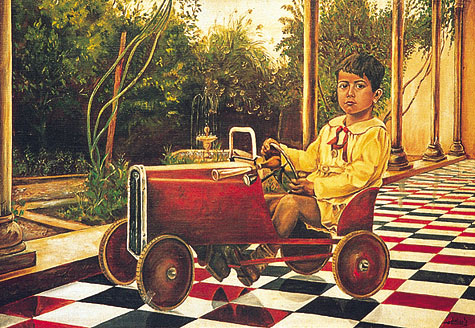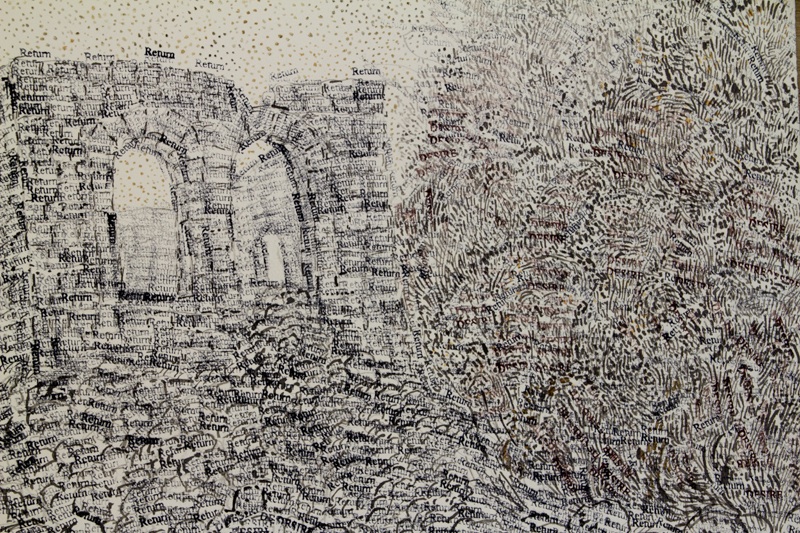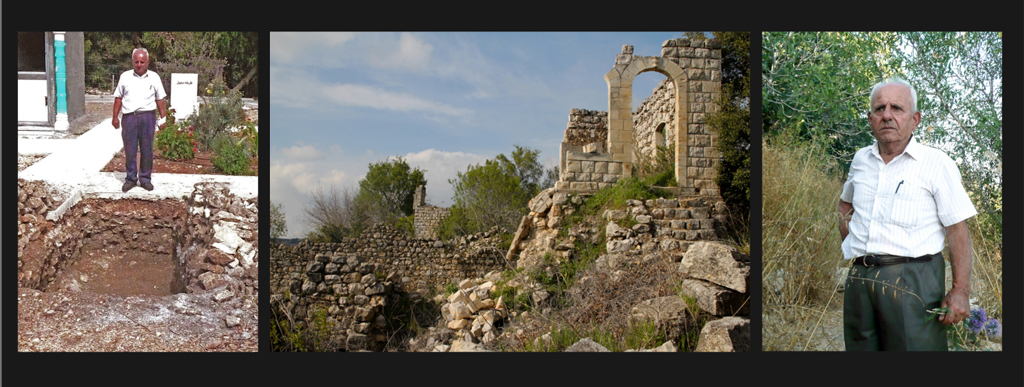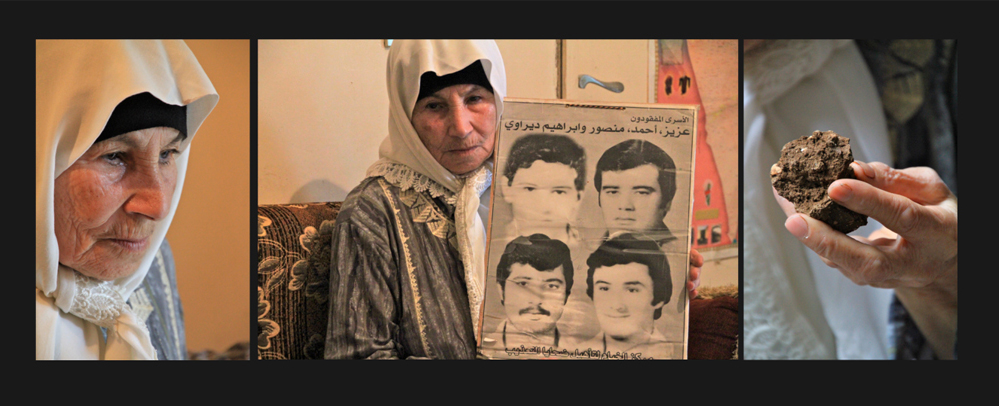When I was invited to write this article for the series Visuals in 1500, I was asked to begin with an image that would help clarify my thinking about the work I do as a visual artist. I decided to focus on a little-known painting that I first became familiar with through a reproduction in Kamal Boullata’s book Palestinian Art: 1850-Present. The painting is attributed to the Palestinian artist Daoud Zalatimo, who was born in Ottoman controlled Jerusalem in 1906 and died in Israeli controlled Jerusalem in 2001.
This private portrait of the painter’s son has haunted me since I first set eyes on it. What strikes me deeply about this image is its casual depiction of the apparent stability, comfort and optimistic vision of life in pre-1948 Palestine. The calm, nurturing and secure environment conveyed in that image, stands in stark contrast to the constant deluge of violence, stress, and chaos that shapes the lives of Palestinians living under occupation or in exile since 1948.
 [Daoud Zalatimo, "The Painter`s Son" (date unknown). Copyright the artist`s estate. Courtesy of John Halaka.]
[Daoud Zalatimo, "The Painter`s Son" (date unknown). Copyright the artist`s estate. Courtesy of John Halaka.]
Daoud Zalatimo’s painting of his son is a rather ordinary domestic portrait that could be easily dismissed as being relevant only to the family that knew the boy depicted in the image. Judging by the composition, the painting was almost certainly copied from a photograph. The boy’s clothes and the toy vehicle that he is placidly ensconced in, suggest that the photograph was taken in the very early years of the 1930’s. (The reproduction in Boullata’s book, as well online images of the painting, bear no date of when it was created.)
Why does this unassuming painting feel like a ghost haunting me? The composition represents an ordinary scene, of an ordinary boy, in an ordinary middle-class Palestinian home. Daoud Zalatimo worked as an art teacher in government schools, he could not have been wealthy, yet the home in which the boy agreeably poses in his toy engine, was tranquil, elegant, secure, comfortable and comforting. The veranda is tiled in black, red, and white squares that look like tiles I’ve seen in so many older middle-class homes in Jaffa, Haifa, Jerusalem, and in the ruins of Lifta. The tiles are meticulously rendered with a carefully delineated perspective that suggests the relatively large span of a ground floor veranda. This outdoor space, like the ubiquitous verandas that graced most older Palestinian homes, likely sheltered several generations of the artist’s family and friends from the hot Mediterranean sun, permitting conversations about past experiences, present activities and future desires. The small, walled garden that appears behind the boy is anchored by a bubbling water fountain and is bordered by lush vines and plants, suggesting a serene and inviting private outdoor refuge.
The boy’s body is perfectly proportional to the red, metal toy car, which is placed in the center of the composition. The young Zalatimo looks directly at us with a calm sense of familiarity and poise. His hands hold the steering wheel, and his feet rest on the pedals, as he patiently pauses from his playful mechanized travel to momentarily accommodate the request of the photographer. Daoud Zalatimo’s depiction of his son’s innocent gaze, as he self-assuredly commands his red engine, suggests the artist’s optimistic vision of a future that would offer a rich array of opportunities for the young boy’s generation.
I have to admit that I have a great affection for old images of faces and places, especially old photographs of Palestinian faces and places. The images that intrigue me the most almost always conjure the comforts and complexities of ordinary times in an ordinary country. They unselfconsciously present a country that was materially and culturally prosperous, as well as a land that was beautiful and bountiful. The faces of men and women that I closely inspect in many old photographs look at us from the distant past with clarity, self-assurance and a sense of cultural generosity. The Palestinian figures in many of those vintage images appear to be closely connected to their urban and rural environments. They look as if they “belong to the land,” without intimating any patronizing, self-conscious, or defensive claims that the land belongs to them.
 [Vera Tamari, "Family Portraits" (1997). Copyright the artist. Courtesy of John Halaka.]
[Vera Tamari, "Family Portraits" (1997). Copyright the artist. Courtesy of John Halaka.]
Zalatimo’s painting reminds me of an important body of work created by the Palestinian artist Vera Tamari in the 1990s. Tamari, whose family was exiled from Jaffa in 1948, also used family photographs as the starting point for her compositions. In her case, the images were developed as intimately scaled ceramic reliefs. The individuals and family groups in this series pose comfortably and elegantly in their domestic environments. The clothes of the figures in Tamari’s tableaux’s suggest an older and distant time, and this sense of faded history is reinforced by the anonymity of her subjects. Their faces are devoid of features, albeit the grouping and gestures of the bodies reveal a bond that can only be created by familial intimacy and cultural rootedness to community and place. Yet, Tamari’s figures appear as ghosts from a fading history; anonymous ghosts instead of real people, as their identity has been erased and denied.
 [John Halaka,"30th Commemoration of the Sabra & Shatila Massacre," (2012) from the series Portraits of Desire & Denial. Copyright the artist.]
[John Halaka,"30th Commemoration of the Sabra & Shatila Massacre," (2012) from the series Portraits of Desire & Denial. Copyright the artist.]
The cultural traditions and familial bonds that defined the normal pace and rhythms of Palestinian life were completely shattered with the beginning of the Nakba (the Great Catastrophe) in 1948. The intricately woven fabric of an ancient, yet evolving Palestinian culture was deliberately shredded by the cruelty of racist colonialist hatred. The ethnic cleansing of Palestine resulted in the violent expulsion of eighty-five percent of the indigenous Palestinian population living on the land that was declared Israel in May of 1948. For the over 800,000 individuals who were expelled from their homes and homeland, their once ordinary domestic lives became little more than faded memories, while the lives of millions of their descendants, who were born and continue to live in exile over the past sixty-five years, are an ongoing nightmare of insecure existence. Since the Nakba, Palestinians living in exile are no longer seen as a people and have been identified primarily as refugees.
Tender experiences and familial securities, like the ones depicted in Zalatimo and Tamari’s images, have become completely abnormal for four generations of Palestinians. The ethnic cleansing of Palestine dismembered a thriving and complex society and transformed its people from land, property and business owners with a deep sense of history and tradition, to stateless and penniless refugees. In a culture that cherished family relations over almost anything else, the cultural foundations of the family were shattered and the members of most Palestinian families have been broadly scattered in an ongoing global diaspora.
 [John Halaka, "Forgotten Survivors" (1993-2003). Mural size drawing. Copyright the artist.]
[John Halaka, "Forgotten Survivors" (1993-2003). Mural size drawing. Copyright the artist.]
My drawing, Forgotten Survivors, attempts to visualize the magnitude of massive human displacement and the restless and seemingly perpetual wandering of refugees in exile. The mural size drawing depicts a large number of naked men and women of various ages, walking towards the viewer’s space from a distant haze. Every figure in this image was carefully rendered with two words that were stamped tens of thousands of times on the canvas: FORGOTTEN SURVIVORS. The assembled marks/words create a flickering field of figures that appear to be disintegrating and/or materializing before our eyes. Confronted by the waves of displaced humanity, the proximity and scale of the figures as well as the magnitude of their plight, the viewer must assess his/her emotional, intellectual and moral relationship and responsibilities to the refugees. Each viewer must decide whether she/he will ignore the plight of the refugees and keep them confined to the bleak reservation of the grey canvas, or to commemorate their survival and work to ensure their security and return.
I have had the great privilege of meeting hundreds of those Forgotten Survivors, and with each encounter, I am repeatedly struck by their complex and compelling stories. Their tragic narratives convey personal experiences of displacement from Palestine, as well as stories of lives spent in exile and/or under occupation. Each of those stories is unique and many are of epic proportions. The most common thread among Palestinian narratives of displacement is the sudden, devastating, and total loss of everything they held dear. Another common thread, is the amazing resilience that most of the refugees have demonstrated through their ability to survive repeated horrors while still prioritizing the well being, education and moral development of their children, who live in unimaginably difficult conditions. It becomes instantly clear when you meet members of exiled Palestinian communities, especially those who spent their lives in the misery of refugee camps, that what we take for granted as normal desires are barely imaginable dreams for the displaced.
 [John Halaka, "Abu Ghazi" (2012), Krayem Kanj. Born El Zeeb, Palestine. Lives in Naher El Bared Refugee Camp, Lebanon, from the series Portraits of Desire & Deinal. Copyright the artist.]
[John Halaka, "Abu Ghazi" (2012), Krayem Kanj. Born El Zeeb, Palestine. Lives in Naher El Bared Refugee Camp, Lebanon, from the series Portraits of Desire & Deinal. Copyright the artist.]
A few years ago, I began to record the stories of Palestinian refugees. I also searched for and photographed their ancestral villages, which were destroyed during and after 1948. Based on the film footage and the photographs I accumulated, I developed a series of drawings depicting the ruins of Palestinian villages that were simultaneously haunting and beautiful. My drawings of devastated stone homes from villages like Kafr Bir`im, Lifta, Al-Bassa, A’mka, and Kuikat, are a declaration that in the face of looming cultural annihilation, the persistence of memory is a crucial act of political resistance and cultural survival. The images are rendered with rubber stamped words. The repeated stamping of the words defines the forms, textures and tones of the landscapes. Most importantly, the repeated words employed to construct those Landscapes of Desire, become a visual mantra, compelling us to “remember,” “resist,” “return,” and “rebuild,” while preparing to “forgive.”
 [Detail of John Halaka`s "Landscapes of Desire: Desire-Survival-Return" (P2-2012). Copyright the artist.]
[Detail of John Halaka`s "Landscapes of Desire: Desire-Survival-Return" (P2-2012). Copyright the artist.]
I have also started working on a series of portrait drawings and photographs of the refugees. I want the faces of those forgotten survivors to emerge from the shadows of history, and for their personal stories to be widely heard. I feel the urgent need to record as many stories as I can, and to preserve and present those narratives to current and future generations that remain ignorant of their details or unmoved by the magnitude of their tragedy. The majority of the refugees have never even been asked to recount their experiences, and very few have had their stories recorded. Consequently, most of the details that make up the first chapter of an epic history of ongoing human suffering, are rapidly vanishing as the 1948-generation dies.
 [John Halaka, "Abu Rayek" (2012), Born in Kafr Bi`rim, Palestine. Lives in Jish, Israel, from the series Portraits of Desire & Denial. Copyright the artist.]
[John Halaka, "Abu Rayek" (2012), Born in Kafr Bi`rim, Palestine. Lives in Jish, Israel, from the series Portraits of Desire & Denial. Copyright the artist.]
I am recording the stories of three generations of Palestinian refugees and gradually producing four closely related bodies of work that are directly informed by the interviews I conduct. Those artworks include drawings, photographs, a documentary film, and an online video archive that will make all of the interviews I’ve recorded available to students, scholars and activist researching modern Palestinian history. The project is called Portraits of Desire and Denial.
One of my objectives in developing this work is to present faces, places and voices that will haunt the viewer long after they have walked away from my images. Just as Zalatimo’s portrait of his son still haunts me with its representation of a tender world that was forcibly deprived of its future, I want my artwork to haunt the viewer with its ghosts of memory, ghosts of resistance, and ghosts of desire that characterize the spirit of the Forgotten Survivors.
 [John Halaka, "Umm Aziz" (2012), Amna Bannat. Born Sheikh Daoud, Palestine. Lives in Borj El Barajneh Refugee Camp, Lebanon, from the series Portraits of Desire & Denial. Copyright the artist.]
[John Halaka, "Umm Aziz" (2012), Amna Bannat. Born Sheikh Daoud, Palestine. Lives in Borj El Barajneh Refugee Camp, Lebanon, from the series Portraits of Desire & Denial. Copyright the artist.]
Umm Aziz was born in the Village of Sheikh Daoud, in northern Palestine, in 1930 and was married at the age of fourteen. In 1948, she was separated from her family while fleeing her village, which came under heavy mortar fire. She ran out of the village bare-footed carrying her two infant daughters in a metal washtub on her head. The one-month old baby was severely injured by shrapnel during the escape and both girls died during the arduous journey out of Palestine. Most of Umm Aziz’s family managed to remain in Palestine and became internally displaced refugees in the newly declared state of Israel, but Umm Aziz could not return to her village or family and joined the columns of displaced Palestinians who made their way into Lebanon. Her husband found her over a year later. They settled in Burj Al Barajneh refugee camp on the outskirts of Beirut, where they had eight more children. Four of her boys were taken from her home and her arms by Lebanese Phalange forces during the Sabra and Shatila massacre in September 1982, and were never seen again. Thirty years after they “disappeared,” she has still not given up hope of their return and listens for their footsteps by her window every night. During the 1985-1987 “War of the Camps,” Umm Aziz’s husband was killed in front of her by an artillery shell that landed very close to their home. She told me during the interview: “I left Palestine and came here walking. If they told me I could go back to Palestine, I would tell them that I would happily return to Palestine walking. In the same way that I left Palestine and came to Lebanon walking, I would return to Palestine walking. But only after I find out the whereabouts of my children. Only after they would tell me what happened to my children. I want to know if they’re alive, or dead, or in prison. I don’t know! I live in a whirlwind."
[The above post is part of Visuals in 1500, a Jadaliyya Culture series on aesthetics.]